INSPECT AIR FUEL RATIO SENSOR (HEATER RESISTANCE)
CHECK TERMINAL VOLTAGE (+B OF A/F SENSOR)
INSPECT NO. 2 INTEGRATION RELAY (A/F)
CHECK HARNESS AND CONNECTOR (NO. 2 INTEGRATION RELAY - A/F SENSOR AND BODY GROUND)
CHECK HARNESS AND CONNECTOR (A/F SENSOR - ECM)
CHECK WHETHER DTC OUTPUT RECURS
DTC P0031 Oxygen (A/F) Sensor Heater Control Circuit Low (Bank 1 Sensor 1) |
DTC P0032 Oxygen (A/F) Sensor Heater Control Circuit High (Bank 1 Sensor 1) |
DTC P0051 Oxygen (A/F) Sensor Heater Control Circuit Low (Bank 2 Sensor 1) |
DTC P0052 Oxygen (A/F) Sensor Heater Control Circuit High (Bank 2 Sensor 1) |
DTC P101D A/F Sensor Heater Circuit Performance Bank 1 Sensor 1 Stuck ON |
DTC P103D A/F Sensor Heater Circuit Performance Bank 2 Sensor 1 Stuck ON |
DESCRIPTION
The A/F sensor generates a voltage* that corresponds to the actual air-fuel ratio. This sensor voltage is used to provide the ECM with feedback so that it can control the air-fuel ratio. The ECM determines the deviation from the stoichiometric air-fuel ratio level, and regulates the fuel injection time. If the A/F sensor malfunctions, the ECM is unable to control the air-fuel ratio accurately.The A/F sensor is the planar type and is integrated with the heater, which heats the solid electrolyte (zirconia element). This heater is controlled by the ECM. When the intake air volume is low (the exhaust gas temperature is low), a current flows into the heater to heat the sensor in order to facilitate accurate airfuel ratio detection. In addition, the sensor and heater portions are the narrow type. The heat generated by the heater is conducted to the solid electrolyte through the alumina, therefore the sensor activation is accelerated.
In order to obtain a high purification rate of the carbon monoxide (CO), hydrocarbon (HC) and nitrogen oxide (NOx) components in the exhaust gas, a TWC is used. For the most efficient use of the TWC, the air-fuel ratio must be precisely controlled so that it is always close to the stoichiometric level.
*: Value changes inside the ECM. Since the A/F sensor is the current output element, a current is converted into a voltage inside the ECM. Any measurements taken at the A/F sensor or ECM connectors will show a constant voltage.
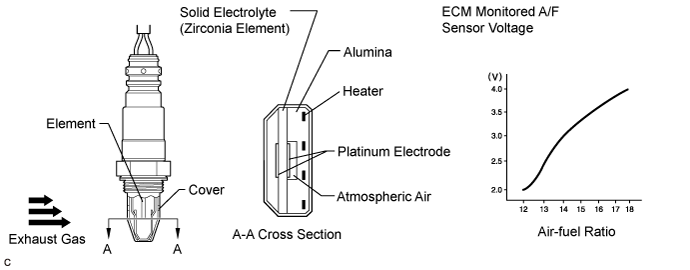
- HINT:
- Although the DTC titles say oxygen sensor, these DTCs relate to the Air Fuel ratio (A/F) sensor.
- Sensor 1 refers to the sensor mounted in front of the Three-Way Catalytic Converter (TWC) and located near the engine assembly.
- When one of these DTCs is stored, the ECM enters fail-safe mode. The ECM turns off the A/F sensor heater in fail-safe mode. Fail-safe mode continues until the engine switch is turned off.
- The ECM provides a pulse width modulated control circuit to adjust the current through the heater. The A/F sensor heater circuit uses a relay on the +B side of the circuit.
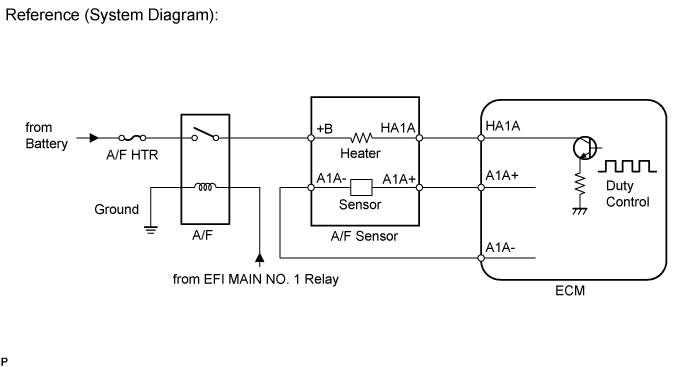
| DTC Code | DTC Detection Condition | Trouble Area |
| P0031 P0051 | The Air Fuel ratio (A/F) sensor heater current is below 0.8 A (1 trip detection logic) |
|
| P0032 P0052 | An Air Fuel ratio (A/F) sensor heater current failure (1 trip detection logic) |
|
| P101D P103D | The heater current is higher than the specified value while the heater is not operating (1 trip detection logic) |
|
MONITOR DESCRIPTION
The ECM uses information from the Air Fuel ratio (A/F) sensor to regulate the air-fuel ratio and keep it close to the stoichiometric level. This maximizes the ability of the Three-Way Catalytic Converter (TWC) to purify the exhaust gases.The A/F sensor detects oxygen levels in the exhaust gas and transmits the information to the ECM. The inner surface of the sensor element is exposed to the outside air. The outer surface of the sensor element is exposed to the exhaust gas. The sensor element is made of platinum coated zirconia and includes an integrated heating element.
The zirconia element generates a small voltage when there is a large difference in the oxygen concentrations between the exhaust gas and outside air. The platinum coating amplifies this voltage generation.
The A/F sensor is more efficient when heated. When the exhaust gas temperature is low, the sensor cannot generate useful voltage signals without supplementary heating. The ECM regulates the supplementary heating using a duty-cycle approach to adjust the average current in the sensor heater element. If the heater current is outside the normal range, the signal transmitted by the A/F sensor becomes inaccurate. As a result, the ECM is unable to regulate the air-fuel ratio properly.
When the current in the A/F sensor heater is outside the normal operating range, the ECM interprets this as a malfunction in the sensor heater and stores DTC(s).
Example:
The ECM stores DTC P0032 or P0052 when the current in the A/F sensor heater is more than 10 A. Conversely, when the heater current is below 0.8 A, DTC P0031 or P0051 is stored.
WIRING DIAGRAM
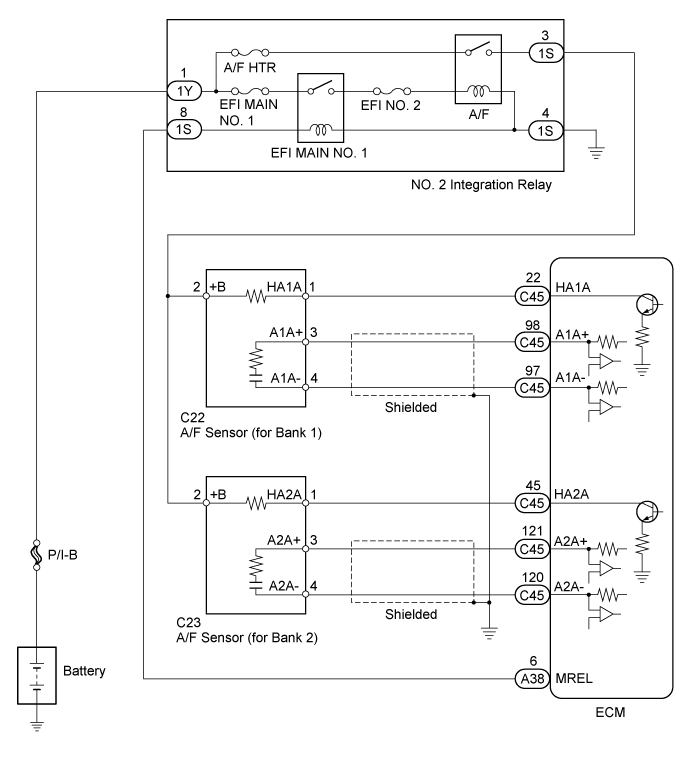
INSPECTION PROCEDURE
- HINT:
- Read freeze frame data using the GTS. Freeze frame data records the engine condition when malfunctions are detected. When troubleshooting, freeze frame data can help determine if the vehicle was moving or stationary, if the engine was warmed up or not, if the air-fuel ratio was lean or rich, and other data from the time the malfunction occurred.
- Bank 1 refers to the bank that includes the No. 1 cylinder*.
*: The No. 1 cylinder is the cylinder which is farthest from the transmission. - Bank 2 refers to the bank that does not include the No. 1 cylinder.
- Sensor 1 refers to the sensor closest to the engine assembly.
- Sensor 2 refers to the sensor farthest away from the engine assembly.
| 1.INSPECT AIR FUEL RATIO SENSOR (HEATER RESISTANCE) |
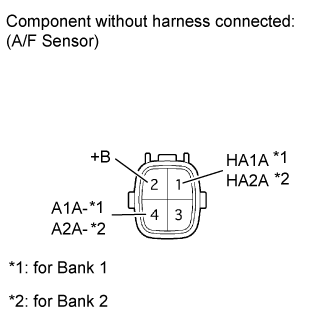 |
Disconnect the C22 or C23 Air Fuel ratio (A/F) sensor connector.
Measure the resistance according to the value(s) in the table below.
- Standard Resistance:
Tester Connection Condition Specified Condition 1 (HA1A) - 2 (+B) 20°C (68°F) 1.6 to 3.2 Ω 1 (HA1A) - 4 (A1A-) Always 10 kΩ or higher 1 (HA2A) - 2 (+B) 20°C (68°F) 1.6 to 3.2 Ω 1 (HA2A) - 4 (A2A-) Always 10 kΩ or higher
|
| ||||
| OK | |
| 2.CHECK TERMINAL VOLTAGE (+B OF A/F SENSOR) |
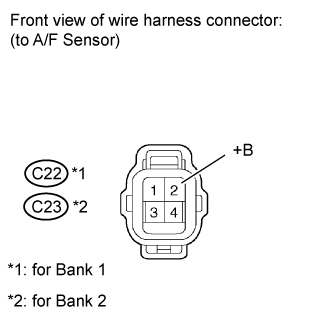 |
Disconnect the C22 or C23 A/F sensor connector.
Measure the voltage according to the value(s) in the table below.
- Standard Voltage:
Tester Connection Switch Condition Specified Condition C22-2 (+B) - Body ground Engine switch on (IG) 11 to 14 V C23-2 (+B) - Body ground Engine switch on (IG) 11 to 14 V
Result Result Proceed to NG A OK B
|
| ||||
| A | |
| 3.INSPECT NO. 2 INTEGRATION RELAY (A/F) |
Remove the No. 2 integration relay from the engine room relay block.
Inspect the No. 2 integration relay (A/F) (Click here).
|
| ||||
| OK | |
| 4.CHECK HARNESS AND CONNECTOR (NO. 2 INTEGRATION RELAY - A/F SENSOR AND BODY GROUND) |
Disconnect the C22 or C23 A/F sensor connector.
Remove the No. 2 integration relay from the engine room relay block.
Measure the resistance according to the value(s) in the table below.
- Standard Resistance:
Tester Connection Condition Specified Condition C22-2 (+B) - 1S-3 Always Below 1 Ω C23-2 (+B) - 1S-3 Always Below 1 Ω 1S-4 - Body ground Always Below 1 Ω C22-2 (+B) or 1S-3 - Body ground Always 10 kΩ or higher C23-2 (+B) or 1S-3 - Body ground Always 10 kΩ or higher
|
| ||||
| OK | ||
| ||
| 5.CHECK HARNESS AND CONNECTOR (A/F SENSOR - ECM) |
Disconnect the C22 or C23 A/F sensor connector.
Disconnect the C45 ECM connector.
Measure the resistance according to the value(s) in the table below.
- Standard Resistance:
Tester Connection Condition Specified Condition C22-1 (HA1A) - C45-22 (HA1A) Always Below 1 Ω C23-1 (HA2A) - C45-45 (HA2A) Always Below 1 Ω C22-1 (HA1A) or C45-22 (HA1A) - Body ground Always 10 kΩ or higher C23-1 (HA2A) or C45-45 (HA2A) - Body ground Always 10 kΩ or higher
|
| ||||
| OK | |
| 6.CHECK WHETHER DTC OUTPUT RECURS |
Connect the GTS to the DLC3.
Turn the engine switch on (IG).
Turn the tester on.
Clear DTCs (Click here).
Start the engine.
Allow the engine to idle for 1 minute or more.
Enter the following menus: Powertrain / Engine and ECT / DTC.
Read DTCs.
Result Result Proceed to No DTC is output A P0031, P0032, P0051, P0052, P101D or P103D is output B
|
| ||||
| A | ||
| ||